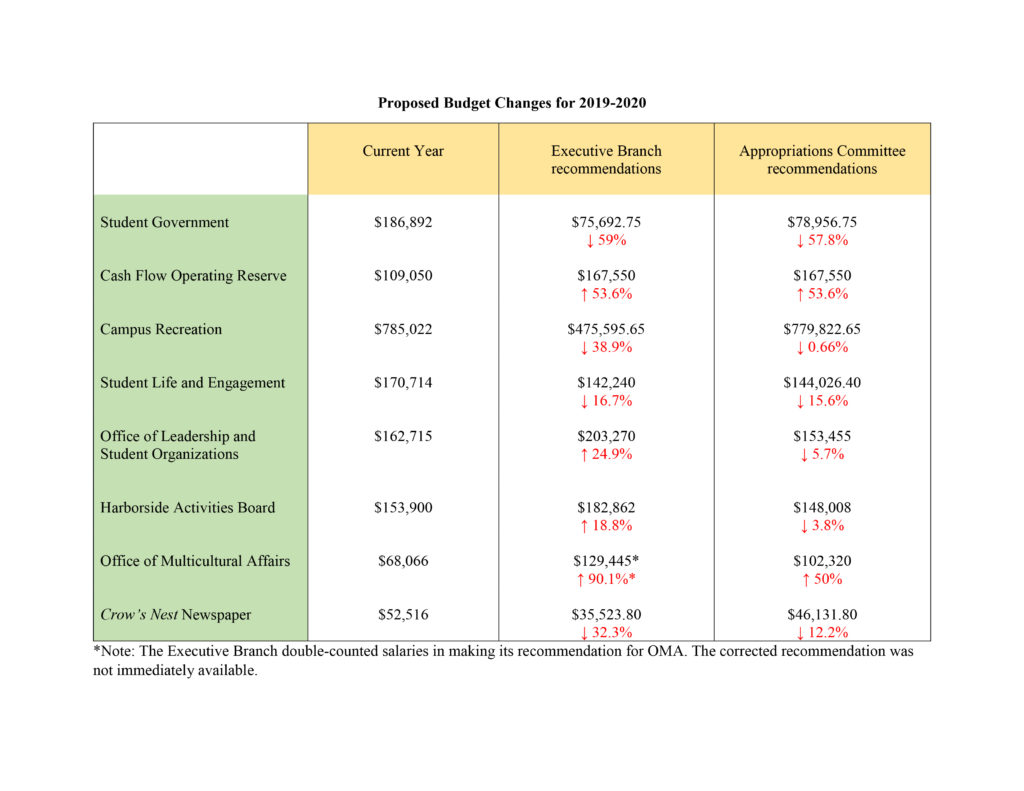
During the budget process, the executive branch of SG makes recommendations that are forwarded to the appropriations committee. That committee, in turn, makes recommendations to the full SG senate. The senate will address these proposed changes for the first time at 5 p.m. on March 18 in the USC ballrooms.
Emily Wunderlich | The Crow’s Nest
By Emily Wunderlich
When Student Government leaders disclosed how they propose to allocate Activities and Services fees to campus organizations in 2019-2020, they said cuts were necessary because revenue is down.
The biggest cut – nearly 60 percent – would come in the allocation for SG itself, they said.
But SG also requested $0 in operating expenses, which totaled $109,050 last year.
Instead, those expenses fell under a different category in the budget: the “cash flow operating reserve,” which SG leaders proposed to increase by 53.6 percent.
In effect, that meant the total proposed cut to SG’s allocation would be 20.5 percent from wages and operating expenses – not the 57.8 percent cited by SG leaders.
The cash flow operating reserve contains A and S funds that were not spent in previous years, SG president Daniel “Kaeden” Kelso said in an email to The Crow’s Nest.
He called it “an emergency fund, or an account to fund major projects and initiatives,” including capital projects, large one-time programs, non-recurring funds and unexpected operating expenses.
“If we were to not use the Cash Flow Operating Reserve and added in our operating expenses in the budget, the reduction to all organizations would have gone up,” Kelso said.
Under the proposal, the reserve would cover $157,550 in SG fees, including its operating expenses and assistant director position — leaving just $10,000 in “unrestricted reserves.”
In response to questions from The Crow’s Nest, Kelso said university administrators have recommended that SG not use the reserve account to fund its operating expenses.
This “error,” he wrote in an email, will be addressed when the SG senate takes up the 2019-2020 spending plan at 5 p.m. on March 18 in the USC ballrooms.
The annual budget exercise is complicated, and the senate will consider recommendations that are sure to be controversial.
Here’s how the budget process works:
Each student pays $25.63 per credit hour in Activities and Services fees every semester. Of that amount, $13.80 automatically goes toward the University Student Center.
The remaining $11.83 is divided among eight organizations by SG.
Some of those organizations, like Campus Recreation, the Harborside Activities Board and SG itself, get large slices of the pie. Other organizations, like the Office of Multicultural Affairs and The Crow’s Nest, get much smaller allocations.
During the budget process, the executive branch of SG – led by Kelso – makes recommendations that are forwarded to the appropriations committee. That committee, in turn, makes recommendations to the full SG senate.
Underlying this year’s budget deliberations is this reality: Because enrollment at the university declined this year, the amount of A and S revenue also declined.
That means SG has $1,450,358 to allocate for 2019-2020 – $28,392 less than the $1,478,750 it allocated this year.
When the SG executive branch made its recommendations, however, its goal was an overall cut of 4 percent, or $58,000.
That was a mistake, according to Gregory Cote, the chair of SG’s appropriations committee.
A and S revenue was down 1.9 percent from last year, not 4 percent.
“The executive branch had made extreme cuts because they thought we were in a more dire situation,” he said. “We did make a lot of cuts, but we didn’t have to make so many.”
Cote’s comments came on March 8 in an appropriations committee meeting with representatives of Campus Recreation and The Crow’s Nest.
Campus Recreation, which runs the fitness center, the waterfront program and sport clubs, was cut nearly 39 percent by the executive branch. But the appropriations committee proposed a reduction of less than 1 percent (see chart).
The Crow’s Nest was cut by nearly $17,000 – or 32 percent – in the executive branch recommendations. But the appropriations committee proposed a much smaller reduction of $6,384, or 12 percent.
Under the 12 percent cut, the newspaper would lose one staff position and its entire photography budget. Salaries of the editor-in-chief and most of the other 11 positions would be cut (an overall reduction of $3,566). The paper would print 13 issues a semester at 500 copies each, down from the current 15 issues at 800 copies each.
Crow’s Nest Editor-in-Chief Whitney Elfstrom criticized the way SG handled the newspaper’s budget.
No one from SG or the university administration advised editors that overall spending must be reduced in 2019-2020, she said, and the SG executive branch did not consult editors before recommending deep cuts in the paper’s budget.
“The Tampa Bay Times recently commended The Crow’s Nest for its ‘excellent news coverage of the consolidation issue,’” Elfstrom said. “A vigorous student press is an important part of student life on our campus, and the SG executive branch proposal to cut our budget by 32 percent was reckless and irresponsible.”
In an email to the newspaper, Kelso, the SG president, said it was his understanding – “from listening to discussions and reviewing minutes” – that the newspaper was “hesitant to make cuts.” So SG leaders were obligated to make trims “in a spirit of equity and fairness to all A&S funded groups,” he said.
Kelso did not explain what he meant by “discussions and reviewing minutes,” and he did not respond to follow-up questions from the newspaper.
But he did offer to set up a meeting with SG leaders and university administrators to review the budget process and “help clean up whatever confusion still exists.”
The Crow’s Nest promptly accepted his offer.
Although SG leaders made cuts in the newspaper’s salaries, it handled its own salaries quite differently.
The recommendations sent to the SG senate call for the elimination of two SG salaried positions. But 23 students would remain salaried SG members under the proposal.
That means SG would spend $78,956.75 on SG salaries.
If the SG senate does not approve the bill on March 18, it would go back to the executive branch for revisions and be resubmitted.
Once the senate approves a proposed budget, it will be sent to Kelso, who can either approve or veto it within 10 business days. If he vetoes it, it goes back to the senate for further deliberations.
Under Florida law, the budget ultimately goes to “the president of the university,” who can “veto any line item” and send it back to SG.
The proposed 2019-2020 budget can be found here.
Proposed salaries in SG total nearly $79,000
Twenty-three students have paid positions in Student Government, with proposed salaries for 2019-2020 that total $78,956.75 — a $4,745.25 difference from last year’s $83,702.
Executive branch
Student body president: $10,968.75
Student body vice president: $8,325
Chief of staff: $5,250
Chief financial officer: $5,250
Chief legal officer: $1,960
Director of communications and graphic design: $3,264
Director of student government relations: $3,264
Director of events: $3,264
Director of sustainable initiatives: $3,264
Director TBA: $3,264
Legislative branch
Senate president: $7,800
Senate president pro tempore: $5,550
Policy chair: $714
Appropriations chair: $714
University research chair: $714
Special funding chair: $714
Judicial branch
Chief justice: $1,260
Ranking justice: $714
Senior justice: $714
Prosecutor: $2,450
University defender: $2,450
Stampete
Executive director: $3,264
Elections rules commission
Chair: $3,825



